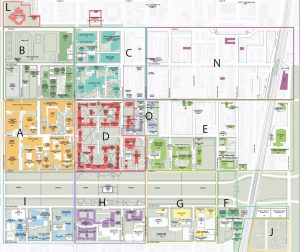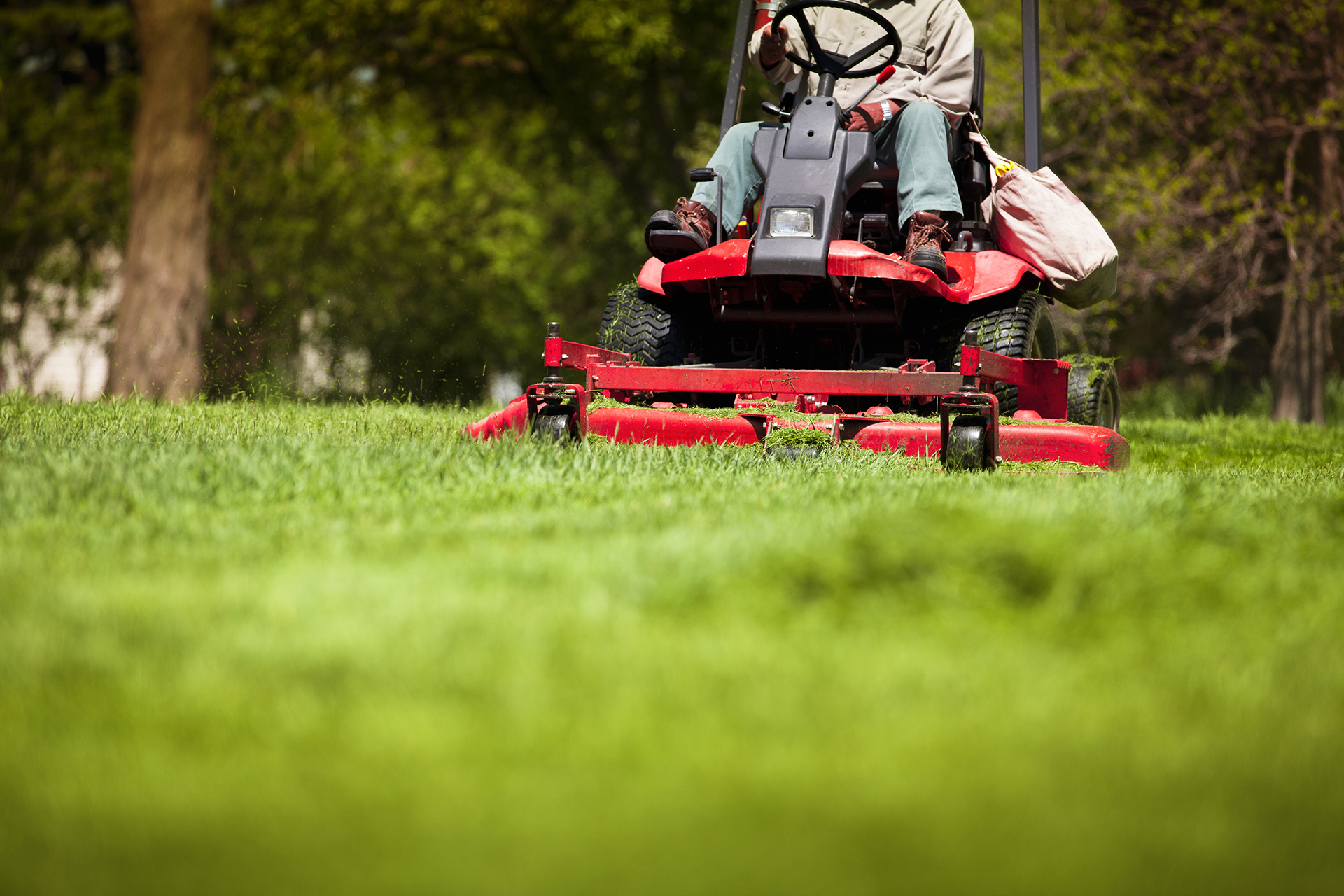The landscape of a facility, be it a university, hospital, or elementary school, is often the first thing visitors see when they arrive. An unsightly landscape can greatly influence guests’ perception of how the rest of their visit will be. The presence of trash, weeds, and unkempt areas can give the impression that there is a lack of care taken in other areas of the facility.
There can be various reasons why a landscape reaches the point where it becomes an eyesore rather than an attractive component that helps to beautify and complement the facility. Often, maintenance strategies can play a large part in whether a landscape is successful. While there are certainly multiple landscape maintenance strategies, and no one strategy that is best for every facility, there are two predominant types of strategies: broadcast maintenance and zone maintenance.
Broadcast Maintenance
One way landscape maintenance can be accomplished is by employing a broadcast maintenance strategy. This strategy uses teams of staff to do the same task every day throughout campus. For example, there might be separate teams for mowing, weeding, trash removal, etc. These teams focus on different sectors of the maintenance area and accomplish their tasks before moving on to another sector the next day. Using the same groups of people for similar tasks every day can be beneficial in that the team becomes efficient because they are completing repetitive work for long stretches of time. However, the repetitive nature of these tasks can also have a negative impact on staff engagement and morale if they are in the same role for extended periods of time.
An option for keeping repetitive tasks from becoming too mundane is to occasionally rotate staff from one maintenance team to another. This can be done seasonally, annually, or as a cross-training exercise to improve redundancy when staff members are absent due to illness or vacations.
The bulk of routine landscaping tasks will be accomplished by the broadcast maintenance teams, but specialized areas of expertise or systems may not need a dedicated team. The irrigation, fine pruning, athletic fields, and tree care needs for some facilities will not need an entire team, but rather a single individual for each specialty who can cover the entire facility.
A benefit of broadcast maintenance is the reduced cost of equipment and vehicles. With this strategy, maintenance teams are usually able to ride to the job site in one vehicle and share a few pieces of equipment among themselves to finish their work. When work is broken up into zones, equipment and vehicle expenses can add up quickly when every staff member needs their own tools to be able to accomplish their tasks efficiently. In addition to extra equipment costs, increased fuel costs and environmental impacts from the additional vehicles required to accomplish work at the facility need to be taken into account.
Another benefit of broadcast maintenance is that new staff can be hired and brought up to speed faster regarding expectations and best practices at the facility when they are working in a team rather than alone. New staff are able to work with a team of experienced employees with little disruption to maintenance activities, whereas a zone maintenance employee will need to shadow someone, leaving a zone unmaintained until he or she is trained.
The team approach used in broadcast maintenance has its benefits, but it certainly has flaws as well. The two biggest drawbacks to broadcast maintenance are lack of staff accountability and lack of a sense of ownership. Lack of accountability can allow weak staff to be carried by their team, which can lead to animosity and a caustic environment if the problem is not corrected before it becomes an issue. When a group of staff is responsible for something, rather than an individual, a significant amount of accountability can be lost. This can lead to mediocre work, as staff can assume the other members of their team will pick up their slack. In addition, there is often times a sense that the staff have no true ownership over an area because they are part of a large group that does just one specific task across the entire landscape. The lack of a sense of ownership by employees working in the landscape can adversely affect their level of job satisfaction, motivation, and morale.
Zone Maintenance
The size and scope of a landscape maintenance area can vary widely from facility to facility. There are small facilities with a few acres of grounds areas needing maintenance, and there are large university campuses with thousands of acres requiring maintenance.

University of Chicago Zone Map.
A common problem with large, sprawling facilities is that some areas may only get touched once a week or every other week. This can lead to litter accumulation and other issues that need to be addressed on a more routine basis.
Zone maintenance strategies can be used to break large grounds maintenance areas into specific grids, or zones, that allow staff to focus on tasks in their own zone rather than the maintenance of the entire landscape portfolio of the institution. Individual zones can be created by using natural geographical boundaries, roadways, sidewalks, or any other means that may be effective and make sense from a maintenance perspective. It is important that zones are split into areas that have an even workload; these areas can be difficult to determine at first and often need to be adjusted as time goes on, in order to balance workloads between zones and to accommodate new maintenance requirements as new facilities and landscapes are created.
Once the maintenance area has been divided into zones, staff can then be assigned to these zones. There are several approaches as to how staff are assigned to zones:
• Skillset
• Preference
• Institutional Knowledge
It is important to keep in mind that certain zones may benefit from a skillset that not every staff member possesses. Some zones may be landscape-bed heavy or turf heavy, and thus better suited for someone with a background in horticulture or turf, respectively. There will also be specialties, such as irrigation, that not every staff member will be an expert on, but an irrigation technician can be used to cover irrigation needs across a large group of zones.
Staff may have a personal preference to be placed in a certain zone. This could be driven by any number of reasons but, regardless of the reason, it can be helpful to have staff in areas they prefer, as it can improve job satisfaction and morale. Certain staff may have experience with certain landscapes, specialties, or specific issues, or know other institution staff in a particular area of campus. In these situations, staff should be placed where their institutional knowledge can best be used. The experience that staff have acquired in certain areas can ensure that problems are addressed proactively and that nothing slips through the cracks.
Zone maintenance allows for landscape areas to get attention on a more routine basis. In a large facility using a broadcast maintenance approach, problems can arise if areas are left for days without anyone tending to them. Having specific staff focus on the same areas day in and day out helps to decrease litter accumulation and can keep small problems from becoming big problems. Staff will become familiar with the nuances of their specific areas, which can help them respond to problems proactively and decrease maintenance costs in the long term. Along with more frequent area inspections, zone maintenance can also increase staff accountability.
It is easier for staff to take shortcuts or not try as hard when they have a team of people to fall back on. When staff are working alone in a zone, they have to rely solely on their individual efforts; this creates a situation in which their lack of effort or poor workmanship will reflect directly on them. Staff may enjoy the increased accountability this approach gives them, as it allows them to work more autonomously and highlights their individual efforts, which may have gone unnoticed in the past.
Financial Decisions
Switching from one maintenance strategy to another certainly takes planning but typically does not entail a long-term planning strategy from an operational perspective. There is, however, a need for a long-term financial plan when switching from broadcast to zone maintenance. Broadcast maintenance allows for staff to share vehicles and equipment because they are functioning as a team that travels and works together. Zone maintenance staff often work independently of each other, requiring their own vehicles and equipment.
The demand for additional vehicles and equipment will need to be included in the budget as a planned capital expense. Additional vehicles and equipment can add up to tens of thousands of dollars or more, depending on the size of the staff and area being maintained. Infrequently used or specialized equipment, such as loaders and aerifiers, can be shared among staff, which helps keep costs down. But pickup trucks, mowers, string trimmers, and other vehicles and equipment that are used frequently need to be supplied for each zone to accomplish work in an efficient and timely manner.
Not Every Shoe Fits
When making the decision whether to use a broadcast-maintenance or zone-maintenance approach, it is important to take into consideration the types of areas being maintained. Some areas will benefit more from a broadcast-maintenance approach, whereas some may benefit more from a zone maintenance approach. Some factors that come into play in determining which approach might be a better fit for the organization include:
Zone Maintenance
• Larger campuses
• Staff that are competent with multiple skillsets
• Significant equipment and tool inventories that allow staff to work independently
• Unified landscape aesthetic that can be applied across the entire facility
• Ability to easily and efficiently divide the campus landscape into zones
Broadcast Maintenance
• Smaller campuses
• Specialized staff that are proficient in certain disciplines
• Small vehicle, equipment, and tool inventories that are not large enough to support a zone maintenance system
• Inability to easily divide the campus into zones
Conclusion
Landscape maintenance and the product that results from it is a critical component of a facility’s operations. Grounds that are unkempt and lack aesthetic appeal impact how a facility and its services are received. The process for how maintenance is planned and executed can be one of the main drivers of how a landscape looks, both in the short term and for years to come.
There is no singular maintenance strategy that is the best fit for every facility. There are strategies that, depending on the type of facility, can be leveraged to provide the best landscape possible with the resources at hand. Selecting a landscape maintenance strategy is not a complicated process, and it can certainly have long-term effects on the landscape, the staff who maintain it, and the recruitment of new students!
Brandon Rux is assistant director of building and landscape services at the University of Chicago; he can be reached at [email protected]. This is his first article for Facilities Manager and was excerpted from the recently published third edition of APPA’s Operational Guidelines for Educational Facilities: Grounds, for which Rux served as co-chair with Marc Fournier of The Trustees of Reservations. The new book is available at the APPA Bookstore.




